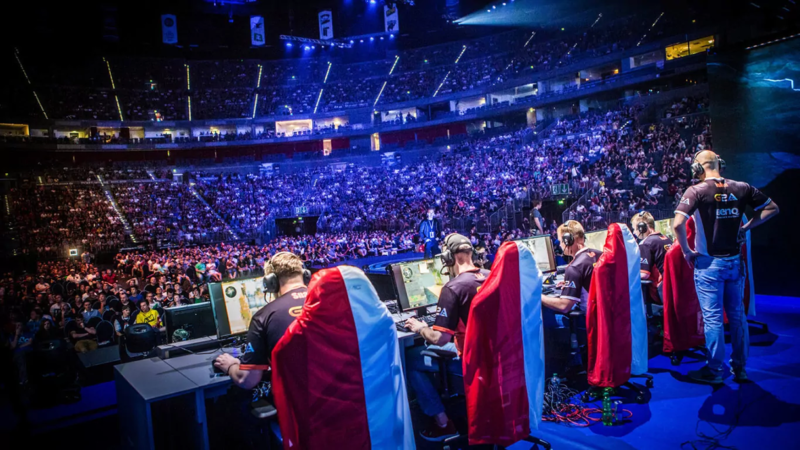The Future of E-sports: How Competitive Gaming is Becoming a Global Phenomenon
October 24, 2024

Over the past decade, e-sports has rapidly evolved from a niche hobby into a global phenomenon, with millions of fans, professional teams, and tournaments offering multimillion-dollar prize pools. What was once a subculture of gaming enthusiasts has grown into a highly competitive, organized, and profitable industry. From massive live events in packed arenas to millions of viewers streaming online, e-sports is reshaping the entertainment landscape and challenging traditional sports in terms of viewership, sponsorship, and cultural relevance.
In this article, we’ll explore the rise of e-sports, its impact on the gaming industry, and the trends that are shaping its future as a global powerhouse in entertainment and competition.
1. The Rise of E-sports: A Brief History
E-sports, or electronic sports, refers to organized competitive gaming where players or teams compete in various video game genres. While video gaming has existed since the 1970s, the concept of competitive gaming began to take off in the late 1990s and early 2000s with the advent of multiplayer online games and tournaments.
Key milestones in the rise of e-sports:
- 1990s: Early tournaments such as the Cyberathlete Professional League (CPL) and games like Quake and StarCraft paved the way for competitive gaming. South Korea’s StarCraft scene, in particular, helped establish e-sports as a legitimate sport.
- 2000s: The rise of broadband internet made online multiplayer gaming more accessible, with titles like Counter-Strike, Warcraft III, and Halo becoming popular in competitive circles.
- 2010s: The launch of streaming platforms like Twitch revolutionized e-sports by giving players and fans a way to broadcast and watch games live. Major tournaments for games like League of Legends, Dota 2, and Overwatch began to attract millions of viewers worldwide.
As technology and internet access improved, e-sports became a global industry, attracting major sponsors, media attention, and professional players.
2. The Global Growth of E-sports
E-sports is now a global phenomenon, with millions of players and fans across continents. Countries like South Korea, China, the United States, and Europe have become major hubs for e-sports, with regional leagues and international tournaments drawing massive audiences.
Factors driving the global growth of e-sports:
- Accessible Entertainment: Unlike traditional sports, e-sports can be played and watched by anyone with an internet connection, making it highly accessible to a global audience.
- Streaming Platforms: Platforms like Twitch, YouTube Gaming, and Facebook Gaming have made it easy for fans to watch live streams and interact with players in real-time, fostering a sense of community.
- Professionalization: E-sports has become more structured, with professional leagues, teams, sponsorship deals, and player contracts mirroring the organization of traditional sports.
- Massive Prize Pools: Tournaments like The International (for Dota 2) and the League of Legends World Championship offer multimillion-dollar prize pools, attracting top talent and media attention.
The global audience for e-sports is projected to reach over 500 million by 2024, driven by younger demographics and the increasing integration of gaming into mainstream culture.
3. E-sports and the Gaming Industry
E-sports is not just a competitive spectacle—it’s also transforming the gaming industry itself. Game developers are increasingly designing games with e-sports in mind, creating titles that are balanced, skill-based, and spectator-friendly.
How e-sports is influencing the gaming industry:
- Game Design: Many modern games, such as Valorant and Overwatch, are designed to be competitive from the outset, with built-in systems for ranking, tournaments, and spectator modes.
- In-Game Monetization: E-sports has influenced the rise of in-game purchases, such as skins, battle passes, and other cosmetic items that help fund tournaments and support professional teams.
- Game Longevity: Competitive games like Counter-Strike: Global Offensive and League of Legends have maintained their popularity for years due to their e-sports communities, keeping player bases engaged long after their initial release.
The symbiotic relationship between e-sports and the gaming industry ensures that competitive gaming will continue to grow as a key pillar of the entertainment sector.
4. E-sports as a Legitimate Career Path
What was once a hobby is now a legitimate career path for many young players. E-sports offers opportunities not just for professional players, but also for content creators, streamers, coaches, analysts, and event organizers. With e-sports scholarship programs at universities and dedicated training facilities, the industry is investing in the development of future talent.
Key elements of e-sports as a career:
- Professional Teams and Leagues: E-sports teams operate similarly to traditional sports teams, with players, coaches, managers, and support staff. Players sign contracts and earn salaries, prize money, and sponsorship deals.
- Streaming and Content Creation: Many professional e-sports players also build personal brands by streaming their gameplay, creating content for platforms like YouTube and Twitch, and interacting with fans.
- Education and Training: Universities and organizations are offering e-sports programs and scholarships, recognizing the potential for gaming careers. Training centers and boot camps also provide professional coaching and development opportunities.
As the e-sports industry matures, it is creating new career opportunities across a wide range of fields, from broadcasting and event management to marketing and game development.
5. The Role of Technology in E-sports
Technology is at the heart of e-sports, and advancements in gaming hardware, internet infrastructure, and streaming platforms are fueling its growth. E-sports is heavily reliant on technology to create a seamless experience for both players and viewers.
Technological innovations driving e-sports:
- High-Performance Hardware: Gaming PCs, high-refresh-rate monitors, and gaming peripherals like keyboards and mice are essential for professional players to compete at the highest level.
- Cloud Gaming: As cloud gaming technology advances, players will be able to compete on powerful servers without needing expensive gaming setups, democratizing access to competitive gaming.
- Virtual Reality (VR) and Augmented Reality (AR): VR and AR technologies are beginning to enter the e-sports space, offering new ways for players to compete and for audiences to engage with the action in immersive environments.
- 5G and Faster Internet: The rollout of 5G networks is set to revolutionize e-sports by reducing latency and allowing for smoother online gameplay, especially for mobile e-sports, which is growing rapidly in regions like Asia.
The integration of cutting-edge technology will continue to shape the future of e-sports, making the experience more immersive, accessible, and competitive.
6. E-sports in the Olympic Games: The Debate
One of the most debated topics in the e-sports community is whether e-sports should be included in the Olympic Games. While some argue that e-sports requires the same level of skill, dedication, and mental acuity as traditional sports, others are hesitant to recognize it as an official Olympic sport.
Arguments for and against e-sports in the Olympics:
- For: E-sports requires incredible reflexes, hand-eye coordination, strategic thinking, and teamwork, qualities that align with traditional Olympic values.
- Against: Critics argue that e-sports lacks the physical athleticism typically associated with the Olympics and raises concerns about violence in certain games.
- Compromise: Some propose including only non-violent e-sports titles or creating a separate category for e-sports within the Olympics to acknowledge its growing influence.
While e-sports has already been included in events like the Asian Games, the debate continues over its potential inclusion in future Olympic Games.
7. The Future of E-sports: Key Trends to Watch
As e-sports continues to grow, several trends are emerging that will shape its future. These trends reflect the ongoing evolution of e-sports into a mainstream entertainment industry.
Key trends shaping the future of e-sports:
- Mobile E-sports: With the rise of mobile gaming in regions like Asia and Latin America, mobile e-sports is becoming a major segment of the industry. Games like Mobile Legends and PUBG Mobile are attracting millions of players and viewers.
- Franchise Leagues: Following the success of the Overwatch League and Call of Duty League, more e-sports titles are adopting franchise models, similar to traditional sports leagues, with city-based teams and structured seasons.
- Cross-Platform Play: As games increasingly support cross-platform play, allowing players on different devices to compete against each other, e-sports will become even more accessible to a wider audience.
- Mainstream Media Partnerships: E-sports is forming partnerships with mainstream media companies, such as ESPN and NBC, bringing competitive gaming to new audiences through traditional television broadcasts.
These trends highlight the continued growth of e-sports and its increasing integration into mainstream entertainment and culture.
Conclusion: The Future of E-sports
E-sports has come a long way from its humble beginnings, and it shows no signs of slowing down. As technology advances and the industry continues to professionalize, e-sports is poised to become a dominant force in global entertainment. With millions of fans, lucrative sponsorships, and massive tournaments, competitive gaming is entering a new era of mainstream acceptance and cultural relevance.
Whether you’re a player, a fan, or a casual observer, the future of e-sports offers exciting opportunities for growth, innovation, and competition on a global scale.







